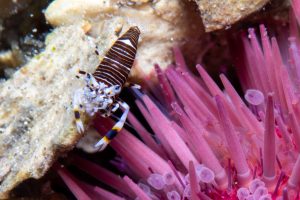Well, I was going to post something else today, but last night was my first dive at the famous Blue Heron Bridge. Because of how things worked out, I ended up jumping right into a night dive, which is cool with me. The start of the dive was a bit nerve wracking to be honest… I had issues with the amount of weight I needed to stay down (new wetsuit!) and there was a really strong current which was not expected. We ended up just resurfacing and standing around in the shallows under the bridge for about 40 minutes waiting for the current to die down.
Eventually we did start the dive and though there was still a little bit of current, it wasn’t anything bad. For those of you who are not divers, I guess I should point out that the Blue Heron Bridge is what is considered a “muck dive”. What that means is there is no coral, and in this case is just a sandy bottom broken up every once in a while by some seaweed or algae or some other random bits. Mainly this is good for searching for weird little stuff – which as you probably know is exactly what I like looking for during dives.
So less than 10 minutes into the dive, I notice this dead leaf on the bottom and it isn’t moving with the current, which is a sign to me that something is worth investigating. So I slowly peel the leaf back and find there is a nice purple urchin underneath. And then I spot the gem for this dive… a Striped Bumblebee Shrimp (Gnathophyllum americanum).
These little shrimp only get to about half an inch long, and this one was smaller than that. They feed on the tube feet of urchins and seastars (echinoderms), and there are other shrimp that tend to be associated with echinoderms (either as allies or as predators), so I always give urchins at least a passing inspection. I found several other purple urchins on this dive, but none of the others seems to have bumblebee shrimp.
I definitely would like to get some good video of these cool little shrimp…


